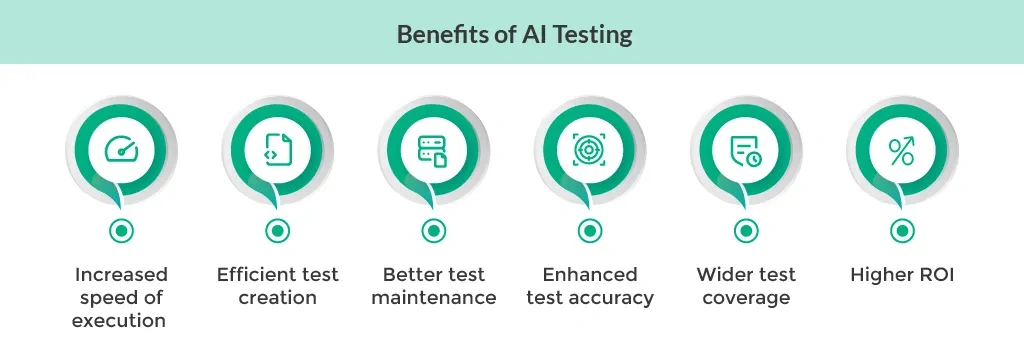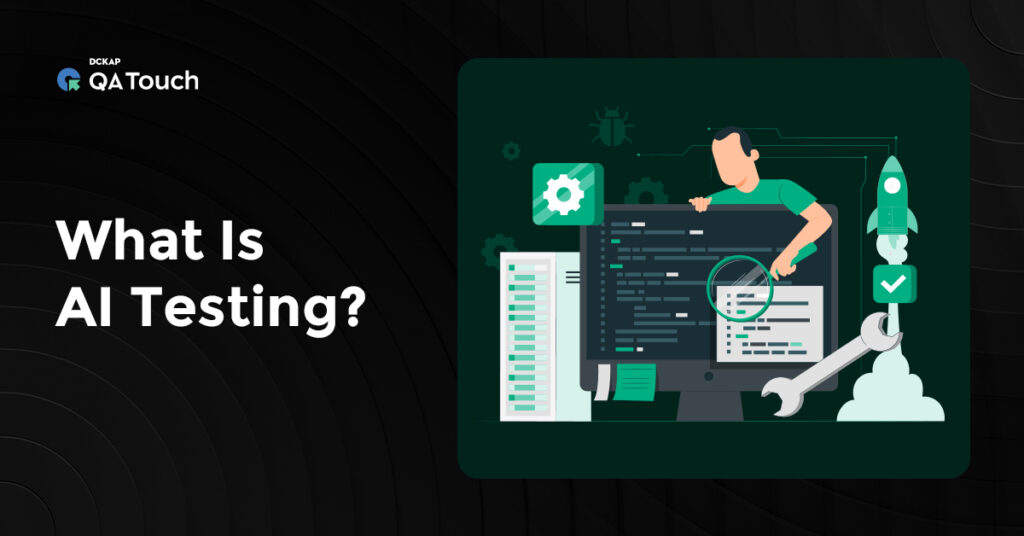Artificial intelligence is transforming the world, bringing unique advancements in technology, healthcare, finance, and countless other fields. The prime focus of AI lies in making machines intelligent. And by intelligent, we mean making machines capable of learning and making decisions like humans—in simple words, being able to adapt and evolve as per the environment. Like other domains, AI plays a significant role in software testing. AI tools assist software testers in automating repetitive tasks, freeing up their time to focus on strategic work.
In this blog, we will discuss the use of AI testing in detail, right from what AI testing is, its benefits, and how software companies can use it to improve QA test efficiency.
What is AI testing?
AI testing involves using Machine Learning algorithms and advanced AI technologies to optimize the different areas of the software testing process. When performing QA testing, we often use a hybrid approach, where we automate certain tasks and use human interventions for specific tasks.
AI-powered testing tools are taking this automation a step ahead. Not only you can automate tedious tasks such as writing and executing test cases, these testing tools can also simulate user interactions, find anomalies, and uncover hidden defects that may go unnoticed in manual testing.
Now, AI testing should not be confused with other terminology—“testing the AI system,” which is the process of testing the effectiveness of AI programs. These programs are built on the concepts of Natural Language Processing (NLP), computer vision, deep neural networks, and deep learning.
This could be an interesting topic to discuss in the future. For now, let’s focus on AI testing and its use in improving the QA processes.
Interesting fact: One-quarter of companies that invested in test automation agreed that their ROI was immediate.
Why you should implement AI testing?
With AI software testing tools, you can overcome the common challenges of traditional test automation, such as delayed test execution, fragile tests, and difficulty maintaining test reports.
Challenges of conventional test automation
- Slow and delayed execution: Traditional test automation frameworks require human intervention. Writing and executing test scripts by hand can be time-consuming, especially for large-scale applications and complex testing scenarios. Delays in execution can be due to poorly designed test scripts, inefficient test case sequencing or inability to run device-specific test cases.
- Complexities in maintaining test scripts: As your software evolves and undergoes changes, test scripts may become outdated or incompatible, requiring frequent updates and modifications to guarantee alignment with the latest requirements and configurations.
- Fragile test: Traditional test automation often creates fragile tests that are overly reliant on specific application behaviors or system configurations. As a result, minor changes or updates to the application code can trigger unexpected test failures or false positives, undermining the reliability of testing efforts. Fragile tests also increase the risk of overlooking critical defects or regressions in production.
- Excessive test maintenance: Finally, traditional test automation often requires excessive test maintenance efforts, including debugging, troubleshooting, and refactoring test scripts to address failures or adapt to changes. This maintenance burden can consume valuable time, diverting focus away from critical testing activities and impacting the agility & responsiveness of testing teams.
With an AI test automation platform, the quality assurance team can overcome these challenges. Here are the benefits of using AI-testing software:

Benefits of AI software testing
Let us have a look at the key features of AI testing:
Increased speed of execution
AI testing accelerates testing cycles by automating repetitive tasks and streamlining test execution processes. For example, the tool can analyse application code and requirement documents to generate test cases. It can also help automate regression testing, where you have to run the same test code multiple times.
Efficient test creation
As mentioned above, AI testing tools use machine learning algorithms to generate test cases based on application requirements, user behaviors, and historical data. This ensures comprehensive test coverage and saves time, enabling testers to focus on higher-level testing activities and strategic test planning.
Better test maintenance
Unlike traditional software test automation, AI testing offers robust and adaptive test maintenance capabilities. AI-powered tools can analyze test results, identify patterns, and update test scripts to accommodate application code or environment changes. The dynamic test maintenance approach reduces manual intervention and minimizes test script fragility.
Enhanced test accuracy
AI-powered testing frameworks improve the accuracy and reliability of test results by minimizing human errors and biases. Through advanced analytics and predictive modeling, AI testing tools can detect anomalies, uncover hidden defects, and identify risk areas with greater precision.
Wider test coverage
AI testing enables broader test coverage by efficiently exploring various test scenarios, edge cases, and user interactions that may be overlooked in manual testing. These tools can also identify critical paths, prioritize test cases, and optimize testing strategies.
Cost-effective
Despite the initial investment required for AI testing tools and infrastructure, the long-term benefits often outweigh the costs, resulting in significant cost savings for companies. With AI- powered automation of software testing, businesses can reduce testing hours while ensuring no defect is slipped into production.
How can you use AI testing automation?
Software companies can use AI testing tools to
- Create test cases
- Generate synthetic test data
- Recommend test cases
- Automate testing techniques like visual and regression testing
- Implement self-healing test automation
- Analyze defect data, prioritize issues
Detailed explanation of these in our next section.
Automatically generate test cases
Chat GPT-based AI testing tool is a great way to effortlessly generate test cases. These tools analyze descriptions of software functionalities or user stories provided by testers or developers using OpenAI’s ChatGPT.
For instance, QA Touch’s Chat-GPT feature allows users to input plain English descriptions of test scenarios, and the AI engine automatically generates corresponding test cases. This streamlines the test case creation process, saves time, and ensures comprehensive test coverage with minimal intervention of manual effort.
Create synthetic data that mimics real-world scenarios
Businesses can use AI algorithms to analyze existing data sets, understand underlying patterns and relationships, and generate synthetic data that resembles real-world scenarios.
The data mimics diverse user behaviour, edge cases and system interactions and can be used in software testing without worrying about data privacy and security compliance.
Enhanced visual testing
Visual testing relies on testers to look at the user interface and graphical elements to find defects and layout inconsistencies. However, AI-powered visual testing tools automatically analyze screen captures or screenshots and detect visual discrepancies.
For example, tools like Applitools leverage AI algorithms to compare baseline and current application screenshots pixel by pixel, flagging differences such as layout shifts, font changes, or missing elements with high accuracy. This accelerates visual testing and reduces the risk of visual defects slipping into production unnoticed.
Regression Automation
Another area where AI testing platforms can help is regression testing. During regression testing, testers run the same set of regression test cases every time a change occurs to ensure that the update does not impact the software functionality and ensures superb software quality.
This can be time-consuming when done manually. However, AI-powered testing tools can automatically identify affected areas, select relevant test cases, and run the tests efficiently. This helps save crucial man-hours and allows testing teams to work on other strategic initiatives.
Self-healing automation
Self-healing automation involves automatically identifying and correcting test failures or discrepancies without human intervention. AI-powered testing tools can analyze test results, detect anomalies, and dynamically adjust test scripts or configurations to accommodate application code or environment changes.
This self-healing capability improves test resilience, reduces false positives, and ensures reliable test outcomes, even in dynamic and evolving testing environments.
Defect analysis and scheduling
AI-powered testing tools analyze defect data, prioritize issues, and schedule defect resolution based on various factors such as severity, impact, and criticality. By applying machine learning algorithms and advanced analytics, these AI testing tools can identify recurring patterns, root causes, and trends in defect data, enabling streamlined defect management.
AI algorithms can also predict defect likelihood and anticipate potential issues so that you can allocate resources and take appropriate action to minimize/ or prevent disruption altogether. In short, AI-powered testing tools help you proactively maintain the software’s overall quality.
Test case recommendation
AI-powered testing tools analyze patterns and historical data to recommend relevant test cases. These tools examine past testing results, defect trends and user feedback to identify high-impact test scenarios and prioritize them accordingly. This helps accelerate test planning and execution.
Case studies and examples of AI testing
All established software companies use AI testing tools to bring efficiency to their quality assurance processes. Here are some examples:
- Facebook’s tool, SapFix, uses AI to generate fixes for the identified bugs. This tool can handle Facebook’s vast code set, leading to a faster bug-fixing process and efficient update deployment.
- Companies like Waymo, Tesla, and Uber have extensively tested their autonomous vehicle systems using AI. They conduct various tests, including simulations, real-world driving scenarios, and controlled environments, to ensure the safety and reliability of their AI-driven navigation systems.
- IBM Watson, a cognitive computing platform, underwent extensive testing before deployment in various domains such as healthcare, finance, and customer service. Testing included verifying the accuracy of natural language processing (NLP) algorithms, evaluating the performance of machine learning models, and validating the system’s ability to generate relevant insights from large datasets.
AI testing best practices and strategies
AI testing has emerged as a game changer for businesses and organizations. However, to make the most of AI, you must adopt certain practices and strategies that align with your business goals. Here are some of the best practices you can follow:
- Define a clear objective: Before you begin with AI testing, it is important to understand what you aim to achieve with this approach. Whether you want to improve test coverage, accelerate test execution, or enhance defect detection, having a clear picture will help you gain the best output for your organization.
- Learn prompt engineering: With prompt engineering, you can guide AI models to generate relevant outputs. Prompt engineering is crucial for testers to produce accurate and actionable results. It involves formulating clear and contextually relevant prompts summarising the testing requirements and desired outcomes.
- Adopt a multifaceted approach: While an AI automation tool can significantly augment testing efforts, it’s essential not to rely solely on AI-driven testing solutions. Rather using a multifaceted approach that combines AI automation with manual testing approaches like exploratory testing techniques is ideal. This hybrid approach provides better test coverage and helps uncover otherwise hidden defects.
- Promote collaboration: Collaboration between testers, developers, and other stakeholders is crucial for the success of AI testing initiatives. By adopting open communication and collaboration, teams can share insights, align testing priorities, and collectively address challenges encountered during testing.
- Invest in the right skills and tools: Building proficiency in AI testing requires the right skills and tools. Provide training to your QA testers so that they can upskill their knowledge in AI technologies, machine learning algorithms, and data analysis. Also, invest in AI testing tools and platforms that align with your organization’s needs and requirements.
Challenges of AI in software testing
Businesses can adopt AI software testing to achieve a lot. However, there are certain challenges associated with it:
Lack of quality training data
Limited and poor-quality data can be a roadblock when implementing AI in software testing. According to a report, poor data can cost organizations an average of $15 million per year. So, to effectively use AI, you need accurate and clean data labelling. Organizations need to protect data used by AI models and ensure compliance with regulations such as GDPR and CCPA. How can this be achieved? One way testers can achieve this is by collecting data based on user interactions, system performance, and defect occurrences.
For instance, let’s say you are looking to increase the test coverage using machine learning algorithms. Now, we know that these algorithms work best with large data sets. But if the data doesn’t represent real-life situations well or doesn’t have enough variety, these algorithms might fail.
Integration with Existing Workflows
Another problem with using AI in software testing is making it work smoothly with your current testing methods. Many organizations already have well-established processes and systems in place, so implementing AI tools into these systems can be challenging.
You need careful planning and coordination to align AI tools with our existing workflows without causing too much disruption. You should also train testers on how to use and implement AI in the testing process.
Career Insight: Skills required for AI testing
AI in the software testing industry has a long way to go. Human testers can prepare themselves for the AI testing era by learning the following skills:
- Test automation tools help streamline testing processes by automating the execution of test cases. Therefore, you need to have a thorough understanding of software testing tools, such as Selenium, Appium and Katalon Studio, as well as AI/ ML concepts.
- As AI testing involves analyzing vast data sets, knowledge of programming languages, data science, and analytics is crucial. It will help you address biases, evaluate the reliability of AI systems, and ensure ethical and fair performance.
AI testing will witness significant growth in the coming years. That’s why staying up-to-date with the latest skills, trends, and technology is paramount. There are plenty of courses that can help you gain these skills.
Here are some of the online courses and certifications on AI testing:
- Generative AI for Testers by Test Tribe
- The ISTQB® AI Testing (CT-AI) certification
- Artificial Intelligence (AI) in Software Testing by Udemy
- Fundamentals of AI testing by Trifork
Automate Test Creation with ChatGPT-powered QA Touch
AI is changing how software testing works. QA teams can now use ChatGPT to write test cases and machine learning and predictive analytics to easily find and resolve bugs. By using AI in testing tools, companies not only reduce the time and effort required to develop a product but also ship highly efficient products faster than ever before.
We have also incorporated AI into our platform to help you with your testing processes. You can now use Chat-GPT to prepare and execute test cases directly on QA Touch’s test management platform. Want to see how it works? Sign up today.
It’s free till you are ready to upgrade your subscription.








